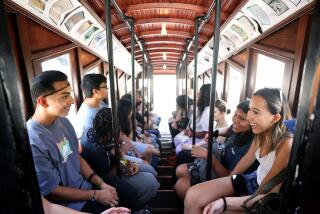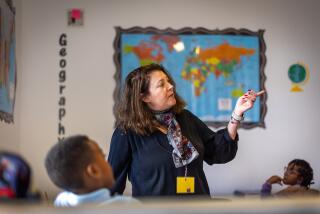Teacher Helps Put Students Into a World of Their Own
- Share via
For the long-suffering colonists of Hammertown, the final indignity came when the king announced a steep tax to pay for his lavish parties and castle renovations.
The students from Kathleen Fletcher’s fifth-grade class in Covina--a.k.a. residents of the mythical Hammertown--did what unhappy colonists throughout history have done.
They launched a revolution.
Next, the Cedargrove Elementary School pupils drew up a Constitution, designed their own currency, flag and passports, set up laws and courts, elected a president and opened businesses to stimulate the economy.
The yearlong project, which weaves in math, history, writing and art, makes abstract ideas come alive for children by allowing them to create their own “mini-societies.”
It is the brainchild of Fletcher, a teacher with Charter Oak Unified School District in Covina, who has been helping children create “mini-societies” for the past 10 years.
Since she designed the 91-page “Mini-Society Workbook” three years ago, more than 200 teachers throughout California, and several in Kansas and Oregon, have begun using the concept to teach everything from U.S. history to accounting and creative writing.
“When they make up their own Constitution and have a chance to think of what kinds of rights and needs they have, it becomes more concrete for them,” said Sue Braithwaite, who teaches fifth- and sixth-graders at the Greenway Elementary School in Beaverton, Ore. Braithwaite also invites local civic groups and businesses to work with her mini-society, called “Squishum.”
Last month, about 20 local mini-societies with names like Beach Bad City, Kidsland and Stomperville converged on the Cedargrove athletic field for a daylong fair in which students sampled one another’s wares, visited each other’s turf and compared laws and constitutions.
“My dream is to have a world fair with mini-societies from many countries getting together,” said Fletcher.
The first step in forming any mini-society is picking what the pupils would call a righteous name, Fletcher said. This year, her students settled on Hammertown, in part because it echoed the name of the popular rap musician M.C. Hammer.
But students said they also wanted to evoke a society that was still evolving. They named their currency unit--the bolt--and came up with names for boys and girls--Road Warriors and Chiselettes.
The logo of the newly independent state of Hammertown, designed by the class, shows a hammer pounding a nail as paintbrushes spell out the name.
“We learn how to make things and shop; it’s like the real world,” said Tiffany Mitsunaga, 11, as she devoured a mustard-slathered hot dog she bought for 20 bolts from budding entrepreneur Jessie Walter, 10.
It was the hour each week when Hammertown shops were open for business, and many students did a brisk trade in yellow No. 2 pencils, candy, snow cones and hot dogs.
Student vendors have to formulate business plans, take out licenses with the state of Hammertown and, using school equipment, write scripts and shoot videos advertising their products.
“We’re learning about money and how much things cost,” said Jessie, who sold all 15 of his hot dogs that day. He’s earned more than 1,000 bolts since he opened for business several months ago.
Some students use allowance money to buy raw materials for their products, Fletcher said. She helps some students by buying gadgets, such as a button-making machine, which she leases out to students for a percentage of their profits.
Strict accounts are kept in a ledger locked in the Hammertown treasury. At the end of the school year, students spend their earnings at an auction where they can buy loot, such as erasers, small U.S. flags and “Cowabunga” stickers.
Throughout, the idea is to instill in the students a sense of responsibility and self-worth, as well as a sense of how to handle money. The progress of the mini-society mirrors subjects studied in class.
For instance, when Fletcher taught the American Revolution, it was the same time that Hammertown’s king, autocratically played by Cedargrove Principal Roger Klinkhart, began issuing inter-office memos taxing the class for desks, books, pencils and cleaning up the room.
As the class studied the Declaration of Independence, they also penned their own proclamation of sovereignty.
“The King has taken our freedom and happiness and has not respected our rights,” the Hammertown declaration read. “He has imposed taxes on us without our consent. He has used our money to improve his castle, post office, servants and army. He has caused a depression to our colony. . . . We therefore, solemnly publish and declare that the Hammertown colony is, and of right ought to be, a free and independent state.”
Alicia C. Franco, 12, the George Washington of Hammertown, said the class elected her president because she wrote a large part of the declaration.
“In most governments, other people decide how to run things and what they say goes,” said Alicia, who wants to be a lawyer. “But I tell all my people what I want to do and what’s going on, and I let them decide.”
On a recent day, she labored at her business, stuffing flour in small balloons to make “stress balls” that students can squeeze to relieve tension.
“I came up with the idea after seeing them in a store,” she explained.
Just then, Chris Martinez, 11, came running to a visitor with a red pencil inscribed in gold, “The State of Hammertown.”
“Here,” the fifth-grader said. “This is for P.R.”
More to Read
Sign up for Essential California
The most important California stories and recommendations in your inbox every morning.
You may occasionally receive promotional content from the Los Angeles Times.










